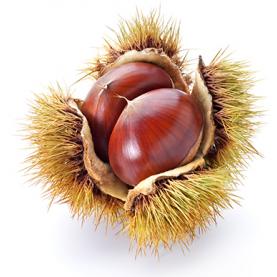Almonds
Almond trees flower early in the year, marking the onset of spring. Almonds, the fruit of the almond tree, are rich in fats and minerals and are consumed in many different ways. They are also used as an ingredient of cosmetic products and medicines.
History of the almond tree
The almond tree has been cultivated in Iran and other countries in Western Asia for over 6000 years. It was introduced to Greece in the 5th century BCE, from where it spread to other European countries after the 3rd century CE. The fruit of the almond tree was seen as a luxury foodstuff and often presented as a gift.
Farming almond trees
Almond trees are sensitive to spring frosts and so grow particularly well in a Mediterranean-type climate. This fruit tree grows to an average height of ten metres and can live for over a hundred years. The almond refers both to the fruit and the nut it contains. Since almond flowers are mainly pollinated by bees, growers often set up beehives nearby. One hectare of almond trees can produce between 800 and 1200 kilos of almonds, depending on the weather conditions, as the fruit is sensitive to wind. How the fruit is harvested depends on how it is going to be consumed: fresh after an end-of-spring harvest, or dry in late summer. California is currently the largest producer and exporter of almonds, although the Mediterranean rim also contributes to a thriving market.
Varieties and by-products
The almond tree, Prunus amygdalus, is a fruit tree from the Rosaceae family and exists in many varieties producing very different types of almond. Its pinkish-white flowers emerge at the end of winter while the branches are still bare. Then the leaves appear, and the velvety, blue-grey-green fruit. The mature fruit of the almond tree, the almond, splits in two as it dries, revealing a core containing a seed (or sometimes two), which is also known as an almond.
The two main varieties of almond come from Prunus amygdalus var. dulcis (sweet almond) and var. amar (bitter almond). Sweet almonds are mainly used in confectionery for manufacturing nougat, marzipan and a wide range of other sweet delights. They are also greatly enjoyed fresh, when they are juicy and crunchy, while the dried form is sweeter and slightly bitter. Bitter almonds can be pressed to extract oil used in a range of medicines, liqueurs, pastries and confectionery. This oil is also used in cosmetics owing to its skin-nourishing properties. However, bitter almonds should not be eaten in large quantities, as they contain precursor compounds of hydrogen cyanide, a particularly powerful poison that renders them toxic.
Nutrition
Fresh sweet almonds are rich in lipids and provide 580 kcal per 100 g, around 20 g of protein and 15 g of fibre. They are also rich in a number of minerals including potassium, calcium and magnesium, and have the advantage of containing very little saturated fatty acids.
Almonds in the human body?
The almond-shaped amygdalae in the human brain take their name from the Greek word for almonds amygdalē. They play a primary role in the processing of memory and emotional reactions.
Sources, ouvrage (s) de référence
Article
HOSTALNOU, Eric, 2008. Amande [en ligne]. Production Développée en Languedoc-Roussillon. [Consulté le 1er avril 2016]. Disponible à l’adresse: http://www.gard.chambagri.fr/fileadmin/Pub/CA30/Internet_CA30/Documents_Internet_CA30/Diversification_Fiches/Fiche_Ammande.pdf
MAKOTO, Iris, 2016. Amandier [en ligne]. [Consulté le 1er avril 2016]. Disponible à l’adresse: http://www.gerbeaud.com/jardin/fiches/amandier.php
Livre
TONELLI Nicole,GALLOUIN François, 2013. Des fruits et des graines comestibles du monde entier. Editions Lavoisier







